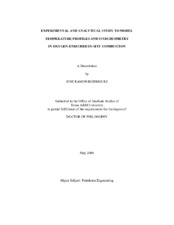Experimental and analytical study to model temperature profiles and stoichiometry in oxygen-enriched in-situ combustion
Abstract
A new combustion zone analytical model has been developed in which the combustion front temperature may be calculated. The model describes in the combustion zone, the amount of fuel burned based on reaction kinetics, the fuel concentration and produced gas composition based on combustion stoichiometry, and the amount of heat generated based on a heat balance.
Six runs were performed in a 3-inch diameter, 40-inch long steel combustion tube with Jobo crude oil (9-11°API) from the Orinoco Belt in Venezuela. These runs were carried out with air containing three values of oxygen concentration, 21%, 30%, and 40%. The weight percentage of sand, clay, water, and oil in the sand mix was kept constant in all runs at 86.6%, 4.7%, 4.0%, and 4.7% respectively. Injection air rates (3 L/min) as well as the production pressure (300 psig) were kept constant in all runs.
The results indicate that the calculated combustion zone temperatures and temperature profiles are in good agreement with the experimental data, for the range of oxygen concentration in the injected air. The use of oxygen-enriched air slightly increased the combustion front temperature from 440°C in a 21 mole % O2 concentration to a maximum of 475°C for air with 40 mole % O2 concentration.
Oxygen-enriched air injection also increased the combustion front velocity from 13.4 cm/hr (for 21% oxygen) to 24.7 cm/hr (for 40% oxygen), thus reducing the start of oil production from 3.3 hours (for 21% oxygen) to 1.8 hours (for 40% oxygen). In the field, the use of oxygen-enriched air injection could translate into earlier oil production compared to with not-enriched air injection.
The new analytical model for the combustion zone developed in this study will be beneficial to future researchers in understanding the effect of oxygen-enriched in-situ combustion and its implications on the combustion front temperature and combustion front thickness.
Subject
air injectioncombustion stoichiometry
in-situ combustion
oxygen-enriched in-situ combustion
thermal recovery
combustion tube experiments
Citation
Rodriguez, Jose Ramon (2003). Experimental and analytical study to model temperature profiles and stoichiometry in oxygen-enriched in-situ combustion. Doctoral dissertation, Texas A&M University. Texas A&M University. Available electronically from https : / /hdl .handle .net /1969 .1 /134.
Related items
Showing items related by title, author, creator and subject.
-
Penberthy, Walter Lawren (Texas A&M University, 1965)Not available
-
Welch, Michael; Igoe, Brian M. (Texas A&M University. Turbomachinery Laboratories, 2013)It is important that gas turbines used in Oil & Gas applications can burn a wide variety of fuels with the minimum impact on the environment or economics. Many types of gaseous and liquid fuels that can be used in Industrial ...
-
Chlubiski, Vincent Daniel (Texas A&M University, 1997)A full factorial experiment was conducted to determine the effects of internal combustion engine ignition parameters on the air-fuel ratio (A/F) lean limit of combustion with compressed natural gas (CNG). Spark electrical ...


